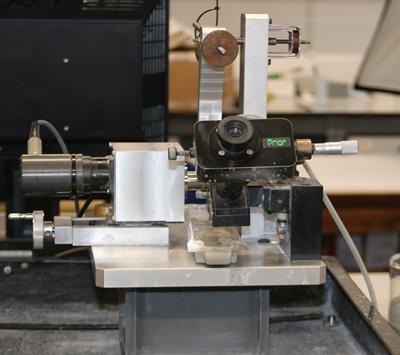Overview
Projects
Specifications
Technical Drawings
The rotation of a ball against a coated plate in the presence of an abrasive slurry results in the production of a circular depression. Eventually the coating is worn through and a “bulls-eye” depression is seen where the substrate shows through. Measurements of the inner and outer diameters of this bulls-eye are easily made and provide an accurate and low cost method of determining coating thickness. This is an established coating thickness measurement technique.
In order to use this configuration for wear coefficient determination it is necessary to measure precisely ball rotational speed, applied load and number of rotations completed (for sliding distance determination). The aim of such a test is to measure progressive wear over an extended number of cycles and thus determine wear rates and wear coefficients of the material (and coating).
In the TE 66 Micro-Scale Abrasion Tester, manufactured by Phoenix Tribology Ltd., the ball is fixed into the rotating shaft and the test surface is mounted on a counterbalanced beam that hangs vertically from a pivot.

A 25 mm ball is clamped between two coaxial shafts each carried in support bearings. One shaft is driven by a variable speed dc geared motor. A batch counter is provided to measure and control the number of shaft revolutions.
The test sample is clamped onto a platform on a vertical beam. The beam is in balance when the samples are just in contact and the load is applied by adding dead weights to a cantilever arm.
Slurry is stored in a container that can be agitated on a laboratory magnetic stirrer. A peristaltic pump is provided for pumping the slurry into the contact. It is fed to a position just above the contact point and collected in a waste tray underneath.
The TE66 conforms to: BS EN 1071-6: 2007
While the TE66 is extensive used for exploring abrasion resistance of coating and monolithic materials, as well as for determination of coating thickness. Some early work actually implemented an electrochemical cell into the rig to perform abrasion-corrosion (or tribocorrosion) measurements.
Papers that have utilised the TE66:
- Interpretation of electrochemical measurements made during micro-scale abrasion-corrosion
- Micro-abrasion mechanisms of cast CoCrMo in simulated body fluids
- Synergistic effects of micro-abrasion–corrosion of UNS S30403, S31603 and S32760 stainless steels
- Micro-abrasion of filled and unfilled polyamide 11 coatings
- Micro-abrasion–corrosion of cast CoCrMo—Effects of micron and sub-micron sized abrasives
- Optimum tests conditions for attaining uniform rolling abrasion in ball cratering tests on hard coatings
- Exposure effects of strong alkaline conditions on the microscale abrasion–corrosion of D-gun sprayed WC–10Co–4Cr coating
- Investigation of micro-scale abrasion–corrosion of WC-based sintered hardmetal and sprayed coating using in situ electrochemical current-noise measurements
- Exposure effects of alkaline drilling fluid on the microscale abrasion–corrosion of WC-based hardmetals
- Influence of load and speed on rolling micro-abrasion of CVD diamond and other hard coatings
- Micro-abrasion–corrosion of a CoCrMo alloy in simulated artificial hip joint environments
- Grooving micro-abrasion of polyamide 11 coated carbon steel tubulars for downhole application
- A ‘3-body’ abrasion wear study of bioceramics for total hip joint replacements
Rig Specifications:
| Attribute | Range/Value |
|---|---|
| Ball Speed Range: | 30 to 150 rpm |
| Load Range: | 0.05 to 5 N |
| Ball Diameter: | 25 mm* |
| Pump Feed Rate: | up to 60 ml/hour |
* - although 1 inch diameter balls are commonly employed
Below is link to download technical drawing for the TE66 samples.
Note that these are generic drawings and are dependent on the type of testing intended and the material, thus should only be used as a guidance.